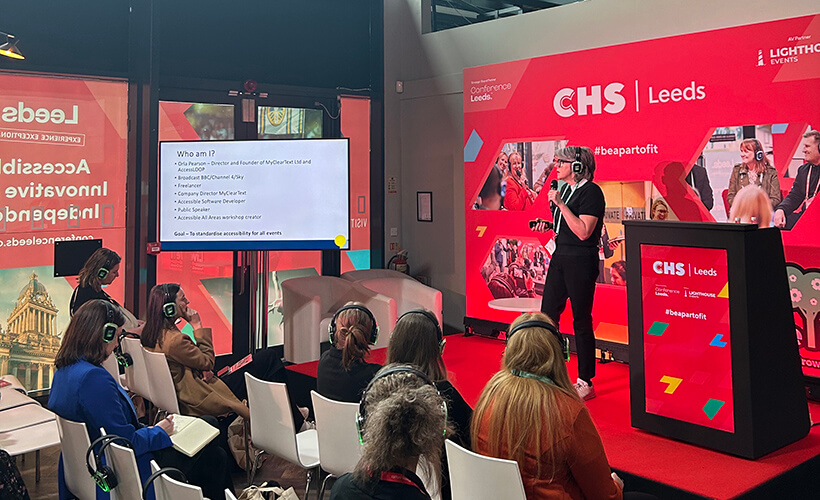Kristyna O’Connell draws some conclusions from a recent session by Orla Pearson, founder of MyClearText and AccessLOOP and expert provider of live captions for events, who spoke on making events more accessible at the recent CHS Leeds event.
Why should events be accessible?
By making events accessible, you broaden your audience, increase attendance, and enhance the visibility of your event as attendees share their positive experiences. Features such as providing a quiet room, clear signage, and designated quiet hours play a crucial role in reducing the stress of overwhelming environments, further improving the overall event experience for everyone.
What are accessibility barriers at events?
For those with hearing impairments, the inability to hear audio can be mitigated by providing captions, sign language interpretation, and ensuring all spoken language is clearly accessible. Visual impairments require that all content, including visual aids and registration processes, be screen readable. Physical access to venues is another common barrier; ensuring that buildings are equipped with ramps, clear maps, and clutter-free spaces is essential. Additionally, the content of the event must be with clear presentations and supplemental captions to aid understanding. The scheduling of the event should accommodate breaks without sudden changes to assist those who may need more time. Environmental factors like appropriate temperature, lighting, and the overall location can significantly affect attendees with disabilities.
Accessibility should be standardised across all events to ensure inclusiveness. For individuals with disabilities, video content without captions is not accessible, leading to exclusion from key information and missing out on engaging a diverse audience. This diversity includes individuals with autism, those who are hearing-impaired, non-native language speakers, and others who benefit from accommodations like live captioning at AGMs. Often, attendees may not request these accommodations, but it is crucial for event organisers to proactively provide them, as they are likely to be used and appreciated. Investing in accessibility is never wasteful; it ensures that all participants feel welcomed, seen, and acknowledged, enhancing their experience and engagement at the event.
Mismanaged durations and poorly timed schedules can also be disruptive, especially if events do not stick to their advertised times or if they are prone to last-minute changes. Environmental factors such as inappropriate lighting and a lack of balance between sustainability and accessibility can create uncomfortable or inaccessible conditions. If a venue is not accessible, do not choose it, it should be as simple as that, was the advice from Pearson, who added that having an inaccessible event excludes a significant portion of potential attendees.
Tips to start making your events accessible:
In her CHS session, Pearson highlighted her top tips for paving the way for accessibility at events: 1. Securing a budget. 2. Building relationships. 3. Initiating conversations.
Establishing a budget is her first recommended step in making your events accessible. Allocate funds specifically for accessibility features to ensure all necessary adjustments can be made, she advises.
Pearson stressed the idea of adopting the mindset of ‘build it and they will come’. This, she believes, can be done by designing your events with accessibility in mind from the outset to naturally attract a diverse audience. Lastly, she said to not wait for attendees to tell you what they need, instead proactively seek information on how to enhance accessibility. Think about how you ask these questions and strive to anticipate their needs rather than reacting to requests.
She concluded her Leeds session with a question: ‘Why should they ask you?’ It is your responsibility to provide options for all attendees to feel welcome and seen; they shouldn’t have to ask you to provide a way for them to attend your event. When they feel included and wanted, they will shout about your event, and you will have successfully organised an accessible event for everyone.




















